R2AK: Are they really braking for whales?
Published on June 12th, 2023
The 7th edition of the 750 mile Race to Alaska (R2AK) began June 5 with a 40-mile “proving stage” from Port Townsend, WA to Victoria, BC. For those that finished within 36 hours, they were allowed to start the remaining 710 miles on June 8 to Ketchikan, AK. Here’s the Stage 2/Day 5 report:
(We think today’s update is best read if you imagine us in a smoking jacket, pipe in hand. A cross between R2AK-fueled masterpiece theater whatever and whatever this was. That established, read on..)
Here’s a debate we just started with ourselves: Team We Brake for Whales’ current program of a walk away, outperform and outlast, cookie-infused, victory-in-the-making is either the most R2AK victory in the history of R2AK or the least.
Discuss.
Hear us out: Fan fave from the get go, TWBFW is also well pedigreed. There’s no fancy wristwatch derived designation (or even Casio for that matter) to bestow any of the crew as a yachtsperson of the year, but they are well accomplished:
Jeanne Goussev is not just a R2AK champ, but in 2017 she became the only woman skipper to run and win on Team Sail Like a Girl. She’s sailing with R2AK veteran and crazy-talented big boat skipper Nikki Henderson, other R2AK veteran Maisey Bryant (2018, Team Blue Flash), and then four other people who have not-for-nothing sailing experience that is no less quotable but we’re going to save for a future update.
What’s more R2AK than low key earned reputation? They are doing this on their family 40-foot monohull. Plus the boat just happens to be gorgeous. And wooden. Strip-built by Lyman Morris in 1983, Graywolf is as fast, as it is safe, as it is classy.
No matter where they finish, they’ll be eligible not just for R2AK glory but for entry into the Port Townsend Wooden Boat Festival. Did you catch that? “Strip built “ is boat talk for “new-fangled wood construction” in which you make a boat out of narrow, bendable strips of wood that are entombed in copious amounts of epoxy and fiberglass.
More than the freshly baked cookies, sh#t-hot boat, and hot-sh#t crew sailing her—Team WBFW is sailing really well. Graywolf’s current alpha status seems as much about the preparation as it is about the execution. Which brings us to the “least R2AK” part of TWBFW: Of all the teams out there, the reports we get from TWBFW are less about what broke and more about how much fun they are having. Fun? Gross. This is supposed to be cathartic.
The only shortcoming/duplicity we can attempt to make stick was from Fisheries Supply Team Monkey Fist: “We have strong suspicions that these guys are NOT, in fact, braking for whales.” Indeed sir, and we pray to god the reciprocal name-driven conclusion can be said about yourselves.
There was other stuff that happened today:
• Team Unsalted Nuts took the scenic route, then set up camp at a remote bay for so long we’re forwarding their mail there.
• Four human powered teams shot the Seymour rapids (look for video proof soon)
• Team Dogsmile Adventures, hailing from the great seafaring state of Idaho, is the current odds on favorite for the steak knives.
• The solo sailing stylings of Team Pestou have a shot at third as long as he continues to not sleep.
• Team Toybox Express invariably did something hot and wholesome. Probably in matching pajamas.
On top of all that, there is a disturbing amount of Nature vs Trimaran violence that feels both similar and disappointingly unrelated to Orcas smashing boats for fun off the coast of Spain.
#1- Team Tres Equis is Mas Breakies: From the lineup in Port Townsend, Team Tres Equis was the boat to beat. Statistically the fastest boat, with a crack crew that included the 2015 Rolex Yachtsman of the Year, all of that and the boat was literally three weeks old.
Their pedal drive was built from a bike one of their brothers asked them to hold onto for a while; they spray painted it in case he saw pictures on social media. Had they not been such nice guys, Team Tres Eqius would have been the obvious villain to typecast.
At the start they said they’d had the boat in their possession for three weeks, and then went on vacation on a different boat for two of those weeks. Then the race started, and that new car smell started to wear off from the jump. As a recap:
• In Stage 1, the main bulkhead (structurally-integrated wall thingy, see Day 2 update for a more full explanation) began to separate from the hull. They patched it up with some hardware store parts and with 60 minutes more cure time than the directions called for, set off to Alaska.
• Stage 2 Day 1: their rudder began to delaminate, and they sailed to the northern tip of San Juan Island, where they backed up their duct tape reinforcements with scavenged 2×4s and ratchet straps.
• Stage 2 Day 3: They were about to make their move on what they called “The whale hippie boat” when they noticed that where their forward beam attached to the hull was not just delaminating, but doing so with enough enthusiasm that water was leaking through. In their words: “The list of stuff we were able to fix beforehand, fix on the fly, is long. But then it gets to the point where now we have some stuff that we can’t fix. And that is a symptom of something that could risk us not being able to self-rescue.”
In case you were wondering the same thing as we were, no, if one hull compromised on a trimaran doesn’t mean you still have two spares (and yes, we did ask).
As of now they are heading to Port Hardy to figure out how to trailer their boat back to where they can file a warranty claim for a new everything.
#2 Team Trimorons regrets their choice of team name: In case the late Corsair designer Ian Farrier needed any reason to turn in his grave and/or come back as Zombie Terminator Apocalypse Jesus, another of his creations decided to throw themselves in to the breach/beach, sacrificing boat and race in an unsuccessful attempt to show a rock who was boss. Translation: Team Trimorons successfully hit a rock last night that filled their cabin with water. In doing so they broke rules two and three of cardinal rules of boating:
1. Keep the people in the boat,
2. Keep the water out of the boat,
3. Keep the boat in the water.
The crew limped their boat to a bay where Teams Monkey Fist and Mike and Marty were waiting for tide and weather. The crew is okay, the boat is not. Their boat has a hole in it that filled their cabin with ankle deep water.
They were able to beach the boat on a falling tide- leaving high and dry and draining to buy time for options. Those options are starting to look like a field repair then a cautious trip to wherever they can haul the boat home to repair it. Live to fight another day.
What’s worse than exiting the race with a hole in your boat? We can only speculate, but part of it has got to be dealing with your team name being lambasted up and down Joint Rescue Forces Canada’s response—not for what you did necessarily but for your actions layered on top of your chosen team name.
From the person who answered the radio, to the reports that were inevitably typed up and shared across the command structure, Canadians are nice but you have to assume that the “moron” part of “Team Trimorons” was inevitably the joke of the week around the office.
Pair that moment when the Canadian Coast Guard can be heard snickering during their radio dispatch about a vessel in need of assistance from any nearby vessel, to realizing that the nearest vessel might be three guys and a sock monkey.
Everyone has bad days, but from personal experience we can say that the day your contingency plans include shoving a sock monkey into a hole in your hull is the day when you question your existence as a mariner.
As of this morning, Team Trimorons are body and soul intact, egos and self confidence maybe, and no sock monkeys were harmed during the making of Day 4. Also, the rock is fine. Thanks for asking.
By mid-today (June 12), Team We Brake for Whales were sailing upwind in light airs in Hecate Strait. Without calamity, logs, Spanish whale attacks, or the ghost of Ian Farrier, it looks like it’s their race to lose.
Ketchikan here we come!
Race details – Entry list – Tracker – Facebook
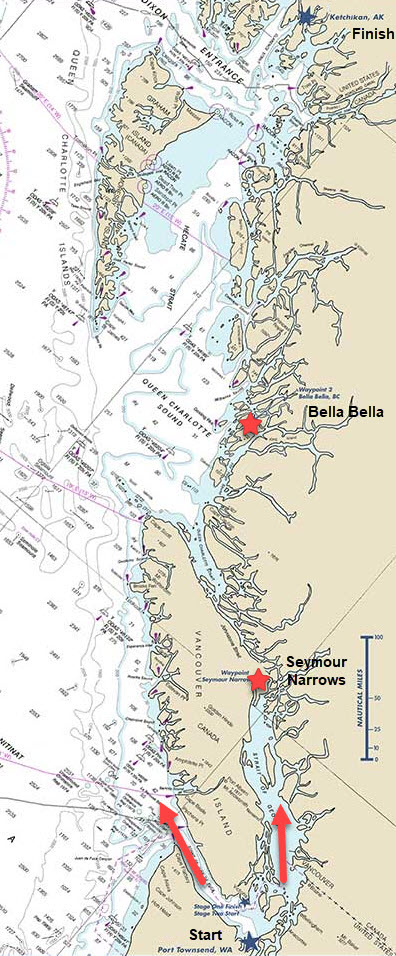 The 7th edition of the Race to Alaska in 2023 will follow the same general rules which launched this madness in 2015. No motor, no support, through wild frontier, navigating by sail or peddle/paddle (but at some point both) the 750 cold water miles from Port Townsend, Washington to Ketchikan, Alaska.
The 7th edition of the Race to Alaska in 2023 will follow the same general rules which launched this madness in 2015. No motor, no support, through wild frontier, navigating by sail or peddle/paddle (but at some point both) the 750 cold water miles from Port Townsend, Washington to Ketchikan, Alaska.
To save people from themselves, and possibly fulfill event insurance coverage requirements, the distance is divided into two stages. Anyone that completes the 40-mile crossing from Port Townsend to Victoria, BC can pass Go and proceed. Those that fail Stage 1 go to R2AK Jail. Their race is done. Here is the 2023 plan:
Stage 1 Race start: June 5 – Port Townsend, Washington
Stage 2 Race start: June 8 – Victoria, BC
While the Stage 1 course is simple enough, the route to Ketchikan is less so. Other than a waypoint at Bella Bella, there is no official course. Whereas previous races mandated an inside passage of Vancouver Island via Seymour Narrows, the gloves came off in 2022. For teams that can prove their seaworthiness, they now had the option of the western route.
There is $10,000 if you finish first, a set of steak knives if you’re second. Cathartic elation if you can simply complete the course. R2AK is a self-supported race with no supply drops and no safety net. Any boat without an engine can enter.
There were no races in 2020 and 2021 due to the pandemic. In 2022, there were 45 starters for Stage 1 and 34 finishers. Of those finishers, 32 took on Stage 2 of which 19 made it to Ketchikan.
Source: R2AK





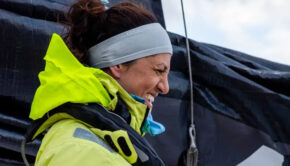
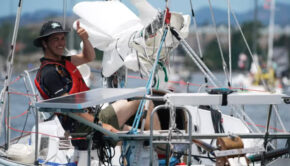
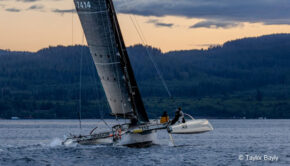
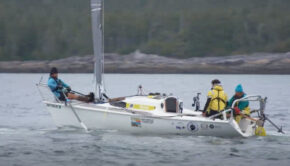
 We’ll keep your information safe.
We’ll keep your information safe.